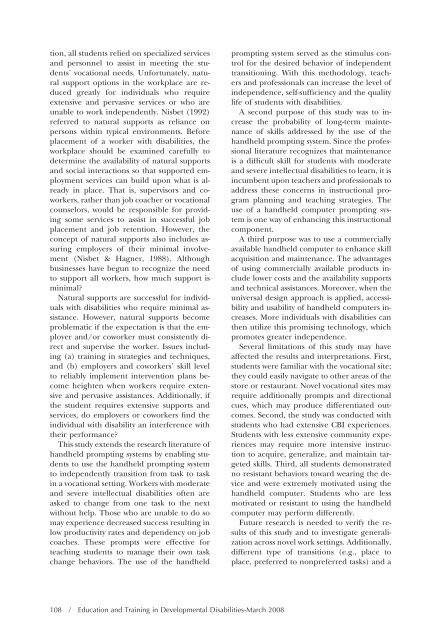Download the Journal (PDF) - Division on Autism and ...
Download the Journal (PDF) - Division on Autism and ...
Download the Journal (PDF) - Division on Autism and ...
You also want an ePaper? Increase the reach of your titles
YUMPU automatically turns print PDFs into web optimized ePapers that Google loves.
ti<strong>on</strong>, all students relied <strong>on</strong> specialized services<br />
<strong>and</strong> pers<strong>on</strong>nel to assist in meeting <str<strong>on</strong>g>the</str<strong>on</strong>g> students’<br />
vocati<strong>on</strong>al needs. Unfortunately, natural<br />
support opti<strong>on</strong>s in <str<strong>on</strong>g>the</str<strong>on</strong>g> workplace are reduced<br />
greatly for individuals who require<br />
extensive <strong>and</strong> pervasive services or who are<br />
unable to work independently. Nisbet (1992)<br />
referred to natural supports as reliance <strong>on</strong><br />
pers<strong>on</strong>s within typical envir<strong>on</strong>ments. Before<br />
placement of a worker with disabilities, <str<strong>on</strong>g>the</str<strong>on</strong>g><br />
workplace should be examined carefully to<br />
determine <str<strong>on</strong>g>the</str<strong>on</strong>g> availability of natural supports<br />
<strong>and</strong> social interacti<strong>on</strong>s so that supported employment<br />
services can build up<strong>on</strong> what is already<br />
in place. That is, supervisors <strong>and</strong> coworkers,<br />
ra<str<strong>on</strong>g>the</str<strong>on</strong>g>r than job coacher or vocati<strong>on</strong>al<br />
counselors, would be resp<strong>on</strong>sible for providing<br />
some services to assist in successful job<br />
placement <strong>and</strong> job retenti<strong>on</strong>. However, <str<strong>on</strong>g>the</str<strong>on</strong>g><br />
c<strong>on</strong>cept of natural supports also includes assuring<br />
employers of <str<strong>on</strong>g>the</str<strong>on</strong>g>ir minimal involvement<br />
(Nisbet & Hagner, 1988). Although<br />
businesses have begun to recognize <str<strong>on</strong>g>the</str<strong>on</strong>g> need<br />
to support all workers, how much support is<br />
minimal?<br />
Natural supports are successful for individuals<br />
with disabilities who require minimal assistance.<br />
However, natural supports become<br />
problematic if <str<strong>on</strong>g>the</str<strong>on</strong>g> expectati<strong>on</strong> is that <str<strong>on</strong>g>the</str<strong>on</strong>g> employer<br />
<strong>and</strong>/or coworker must c<strong>on</strong>sistently direct<br />
<strong>and</strong> supervise <str<strong>on</strong>g>the</str<strong>on</strong>g> worker. Issues including<br />
(a) training in strategies <strong>and</strong> techniques,<br />
<strong>and</strong> (b) employers <strong>and</strong> coworkers’ skill level<br />
to reliably implement interventi<strong>on</strong> plans become<br />
heighten when workers require extensive<br />
<strong>and</strong> pervasive assistances. Additi<strong>on</strong>ally, if<br />
<str<strong>on</strong>g>the</str<strong>on</strong>g> student requires extensive supports <strong>and</strong><br />
services, do employers or coworkers find <str<strong>on</strong>g>the</str<strong>on</strong>g><br />
individual with disability an interference with<br />
<str<strong>on</strong>g>the</str<strong>on</strong>g>ir performance?<br />
This study extends <str<strong>on</strong>g>the</str<strong>on</strong>g> research literature of<br />
h<strong>and</strong>held prompting systems by enabling students<br />
to use <str<strong>on</strong>g>the</str<strong>on</strong>g> h<strong>and</strong>held prompting system<br />
to independently transiti<strong>on</strong> from task to task<br />
in a vocati<strong>on</strong>al setting. Workers with moderate<br />
<strong>and</strong> severe intellectual disabilities often are<br />
asked to change from <strong>on</strong>e task to <str<strong>on</strong>g>the</str<strong>on</strong>g> next<br />
without help. Those who are unable to do so<br />
may experience decreased success resulting in<br />
low productivity rates <strong>and</strong> dependency <strong>on</strong> job<br />
coaches. These prompts were effective for<br />
teaching students to manage <str<strong>on</strong>g>the</str<strong>on</strong>g>ir own task<br />
change behaviors. The use of <str<strong>on</strong>g>the</str<strong>on</strong>g> h<strong>and</strong>held<br />
108 / Educati<strong>on</strong> <strong>and</strong> Training in Developmental Disabilities-March 2008<br />
prompting system served as <str<strong>on</strong>g>the</str<strong>on</strong>g> stimulus c<strong>on</strong>trol<br />
for <str<strong>on</strong>g>the</str<strong>on</strong>g> desired behavior of independent<br />
transiti<strong>on</strong>ing. With this methodology, teachers<br />
<strong>and</strong> professi<strong>on</strong>als can increase <str<strong>on</strong>g>the</str<strong>on</strong>g> level of<br />
independence, self-sufficiency <strong>and</strong> <str<strong>on</strong>g>the</str<strong>on</strong>g> quality<br />
life of students with disabilities.<br />
A sec<strong>on</strong>d purpose of this study was to increase<br />
<str<strong>on</strong>g>the</str<strong>on</strong>g> probability of l<strong>on</strong>g-term maintenance<br />
of skills addressed by <str<strong>on</strong>g>the</str<strong>on</strong>g> use of <str<strong>on</strong>g>the</str<strong>on</strong>g><br />
h<strong>and</strong>held prompting system. Since <str<strong>on</strong>g>the</str<strong>on</strong>g> professi<strong>on</strong>al<br />
literature recognizes that maintenance<br />
is a difficult skill for students with moderate<br />
<strong>and</strong> severe intellectual disabilities to learn, it is<br />
incumbent up<strong>on</strong> teachers <strong>and</strong> professi<strong>on</strong>als to<br />
address <str<strong>on</strong>g>the</str<strong>on</strong>g>se c<strong>on</strong>cerns in instructi<strong>on</strong>al program<br />
planning <strong>and</strong> teaching strategies. The<br />
use of a h<strong>and</strong>held computer prompting system<br />
is <strong>on</strong>e way of enhancing this instructi<strong>on</strong>al<br />
comp<strong>on</strong>ent.<br />
A third purpose was to use a commercially<br />
available h<strong>and</strong>held computer to enhance skill<br />
acquisiti<strong>on</strong> <strong>and</strong> maintenance. The advantages<br />
of using commercially available products include<br />
lower costs <strong>and</strong> <str<strong>on</strong>g>the</str<strong>on</strong>g> availability supports<br />
<strong>and</strong> technical assistances. Moreover, when <str<strong>on</strong>g>the</str<strong>on</strong>g><br />
universal design approach is applied, accessibility<br />
<strong>and</strong> usability of h<strong>and</strong>held computers increases.<br />
More individuals with disabilities can<br />
<str<strong>on</strong>g>the</str<strong>on</strong>g>n utilize this promising technology, which<br />
promotes greater independence.<br />
Several limitati<strong>on</strong>s of this study may have<br />
affected <str<strong>on</strong>g>the</str<strong>on</strong>g> results <strong>and</strong> interpretati<strong>on</strong>s. First,<br />
students were familiar with <str<strong>on</strong>g>the</str<strong>on</strong>g> vocati<strong>on</strong>al site;<br />
<str<strong>on</strong>g>the</str<strong>on</strong>g>y could easily navigate to o<str<strong>on</strong>g>the</str<strong>on</strong>g>r areas of <str<strong>on</strong>g>the</str<strong>on</strong>g><br />
store or restaurant. Novel vocati<strong>on</strong>al sites may<br />
require additi<strong>on</strong>ally prompts <strong>and</strong> directi<strong>on</strong>al<br />
cues, which may produce differentiated outcomes.<br />
Sec<strong>on</strong>d, <str<strong>on</strong>g>the</str<strong>on</strong>g> study was c<strong>on</strong>ducted with<br />
students who had extensive CBI experiences.<br />
Students with less extensive community experiences<br />
may require more intensive instructi<strong>on</strong><br />
to acquire, generalize, <strong>and</strong> maintain targeted<br />
skills. Third, all students dem<strong>on</strong>strated<br />
no resistant behaviors toward wearing <str<strong>on</strong>g>the</str<strong>on</strong>g> device<br />
<strong>and</strong> were extremely motivated using <str<strong>on</strong>g>the</str<strong>on</strong>g><br />
h<strong>and</strong>held computer. Students who are less<br />
motivated or resistant to using <str<strong>on</strong>g>the</str<strong>on</strong>g> h<strong>and</strong>held<br />
computer may perform differently.<br />
Future research is needed to verify <str<strong>on</strong>g>the</str<strong>on</strong>g> results<br />
of this study <strong>and</strong> to investigate generalizati<strong>on</strong><br />
across novel work settings. Additi<strong>on</strong>ally,<br />
different type of transiti<strong>on</strong>s (e.g., place to<br />
place, preferred to n<strong>on</strong>preferred tasks) <strong>and</strong> a
















